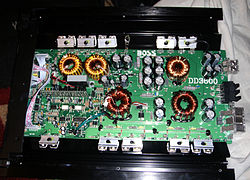- Class-D amplifier
-
A class-D amplifier or switching amplifier is an electronic amplifier where all power devices (usually MOSFETs) are operated as binary switches. They are either fully on or fully off. Ideally, zero time is spent transitioning between those two states.
Output stages such as those used in pulse generators are examples of class D amplifiers. However, the term mostly applies to power amplifiers intended to reproduce signals with a bandwidth well below the switching frequency.
Contents
Basic operation
Class D amplifiers work by generating a square wave of which the low-frequency portion of the spectrum is essentially the wanted output signal, and of which the high-frequency portion serves no purpose other than to make the wave-form binary so it can be amplified by switching the power devices.
A passive low-pass filter removes the unwanted high-frequency components, i.e., smooths the pulses out and recovers the desired low-frequency signal. To maintain high efficiency, the filter is made with purely reactive components (inductors and capacitors), which store the excess energy until it is needed instead of converting some of it into heat. The switching frequency is typically chosen to be ten or more times the highest frequency of interest in the input signal. This eases the requirements placed on the output filter. The low pass filter is sometimes not implemented because most loudspeakers do not make sound in response to the switching frequency (though they may increase in heat) and the human ear cannot identify such high frequencies.
The structure of a class D power stage is essentially identical to that of a synchronously rectified buck converter, a type of non-isolated switched-mode power supply. Whereas buck converters usually function as voltage regulators, delivering a constant DC voltage into a variable load and can only source current (one-quadrant operation), a class D amplifier delivers a constantly changing voltage into a fixed load, where current and voltage can independently change sign (four-quadrant operation). A switching amplifier must not be confused with any amplifier that uses an SMPS. A switching amplifier may use any type of power supply but the amplification process itself operates by switching.
Theoretical power efficiency of class D amplifiers is 100%. That is to say, all of the power supplied to it is delivered to the load, none is turned to heat. This is because an ideal switch in its on state will conduct all current but has no voltage across it, hence no heat is dissipated. And when it is off, it will have the full supply voltage standing across it, but no current flows through it. Again, no heat is dissipated. Real-life power MOSFETs are not ideal switches, but practical efficiencies well over 90% are common. By contrast, linear AB-class amplifiers are always operated with both current flowing through and voltage standing across the power devices. An ideal class B amplifier has a theoretical maximum efficiency of 78%.
Terminology
The term "class D" is sometimes misunderstood as meaning a "digital" amplifier. While some class D amps may indeed be controlled by digital circuits, the power stage deals with voltage and current as a function of time. The smallest amount of noise, timing uncertainty, voltage ripple or any other non-ideality immediately results in an irreversible change of the output signal. A digital circuit also uses physics to operate, but those same errors will only lead to incorrect results when they become so large that a signal representing a digit is distorted beyond recognition. Up to that point, non-idealities have no impact on the transmitted signal. The difference between digital and analogue signals is that digital signals are subsequently interpreted as numbers whereas in analogue signals the exact waveform matters.[1]
Nevertheless, the term "digital amplifier" has gained currency to denote class D amplifiers with significant amounts of digital processing in them.
Signal modulation
The binary waveform is derived using pulse-width modulation (PWM), pulse density modulation (sometimes referred to as pulse frequency modulation), sliding mode control (more commonly called "self-oscillating modulation" in the trade[2].) or discrete-time forms of modulation such as delta-sigma modulation[3].
The most basic way of creating the PWM signal is to use a high speed comparator ("C" in the block-diagram above) that compares a high frequency triangular wave with the audio input. This generates a series of pulses of which the duty cycle is directly proportional with the instantaneous value of the audio signal. The comparator then drives a MOS gate driver which in turn drives a pair of high-power switches (usually MOSFETs). This produces an amplified replica of the comparator's PWM signal. The output filter removes the high-frequency switching components of the PWM signal and recovers the audio information that the speaker can use.
DSP-based amplifiers which generate a PWM signal directly from a digital audio signal (e.g. SPDIF) either use a counter to time the pulse length e.g.[4] or implement a digital equivalent of a triangle-based modulator. In either case, the time resolution afforded by practical clock frequencies is only a few hundredths of a switching period, which is not enough to ensure low noise. In effect, the pulse length gets quantized, resulting in quantization distortion. In both cases, negative feedback is applied inside the digital domain, forming a noise shaper which has lower noise in the audible frequency range.
Design challenges
Two significant design challenges for MOSFET driver circuits in class D amplifiers are keeping dead times and linear mode operation as short as possible. "Dead time" is the period during a switching transition when both output MOSFETs are driven into Cut-Off Mode and both are "off". Dead times need to be as short as possible to maintain an accurate low-distortion output signal, but dead times that are too short cause the MOSFET that is switching on to start conducting before the MOSFET that is switching off has stopped conducting. The MOSFETs effectively short the output power supply through themselves, a condition known as "shoot-through". Meanwhile, the MOSFET drivers also need to drive the MOSFETs between switching states as fast as possible to minimize the amount of time a MOSFET is in Linear Mode, the state between Cut-Off Mode and Saturation Mode where the MOSFET is neither fully on nor fully off and conducts current with a significant resistance, creating significant heat. Driver failures that allow shoot-through and/or too much linear mode operation result in excessive losses and sometimes catastrophic failure of the MOSFETs [5].
Error control
The actual output of the amplifier is not just dependent on the content of the modulated PWM signal. The power supply voltage directly amplitude-modulates the output voltage, dead time errors make the output impedance non-linear and the output filter has a strongly load-dependent frequency response. An effective way to combat errors, regardless of their source, is negative feedback. A feedback loop including the output stage can be made using a simple integrator. To include the output filter, a PID controller is used, sometimes with additional integrating terms. The need to feed the actual output signal back into the modulator makes the direct generation of PWM from a SPDIF source unattractive [1].
Advantages
Despite the complexity involved, a properly designed class D amplifier offers the following benefits:
- Reduction in size and weight of the amplifier,
- Reduced power waste as heat dissipation and hence smaller (or no) heat sinks,
- Reduction in cost due to smaller heat sink and compact circuitry,
- Very high power conversion efficiency, usually above 90% above one quarter of the amplifier's maximum power, and around 50% at low power levels.
Uses
- Home Theatre systems. In particular the economical "home theatre in a box" systems are almost universally equipped with class D amplifiers. On account of modest performance requirements and straightforward design, direct conversion from digital audio to PWM without feedback is most common.
- Mobile phones. The internal loudspeaker is driven by up to 1 W. Class D is used to preserve battery lifetime.
- Powered speakers
- High-end audio is generally conservative with regards to adopting new technologies but class D amplifiers have made an appearance[6]
- Active subwoofers
- Sound Reinforcement and Live Sound. The Crest Audio CD3000, for example, is a class-D power amplifier that is rated at 1500 W per channel, yet it weighs only 21 kg (46 lb).[7] Similarly, the Powersoft K10 is a class-D power amplifier that is rated at 6000 W per 2-ohm channel, yet it weighs only 12 kg (26.5 lb).[8]
- Bass amplifiers Again, an area where portability is important. Example: Yamaha BBT500H bass amplifier which is rated at 500 W, and yet it weighs less than 5 kg (11 lb).[9] The Promethean P500H by Ibanez is also capable of delivering 500 W into a 4 Ohm load, and weighs only 2.9 kg.
See also
- Class A amplifier (a linear, non-PWM, amplifier class)
- Class B amplifier (a linear, non-PWM, amplifier class)
- Class C amplifier (a non-PWM amplifier class)
- Class T amplifier (a proprietary development of Class D)
- Delta-sigma modulation
- Sliding mode control
References
- ^ a b Putzeys et al. All Amplifiers etc., Presented at the AES 120th convention
- ^ The generic analysis of sliding mode control is quite math heavy. The specific case of 2-state self-oscillating class D amplifiers is much more intuitive and can be found in Globally Modulated Self-Oscillating Amplifier with Improved Linearity, 37th AES Conference
- ^ The Analog Devices AD1990 Class-D audio power amplifier is an example.
- ^ Sandler et al., Ultra-Low Distortion Digital Power Amplification, Presented at the 91st AES convention
- ^ Analytical and numerical analysis of dead-time distortion in power inverters
- ^ Group review of "high end" class D offerings and round-table discussion with amplifier designers
- ^ Crest Audio CD3000 Specifications
- ^ Burning man Festival K10
- ^ Yamaha BBT 500H Specifications
External links
- List of PWM Amplifiers
- Sánchez Moreno, Sergio Class D Audio Amplifiers - Theory and Design [1] - Contains material on the theory and design of Class-D amplifiers.
- Burchers, Glen Digital Amplifiers Come of Age
- Hatfield, Robert Class D Amplifiers Empower Mobile Multimedia - Gives information on working with Class D amplifiers in mobile platforms
- Haber, Eric Designing With Class D Amplifier ICs - Some IC-oriented Class D design considerations
- Harden, Paul Introduction to Class C,D,E and F, The Handiman's Guide to MOSFET "Switched Mode" Amplifiers, Part 1 - An article on basic digital RF amplifier design intended for ham radio operators but applicable to audio Class D amplifiers.
Categories:- Electronic amplifiers
- Switching amplifiers
Wikimedia Foundation. 2010.


